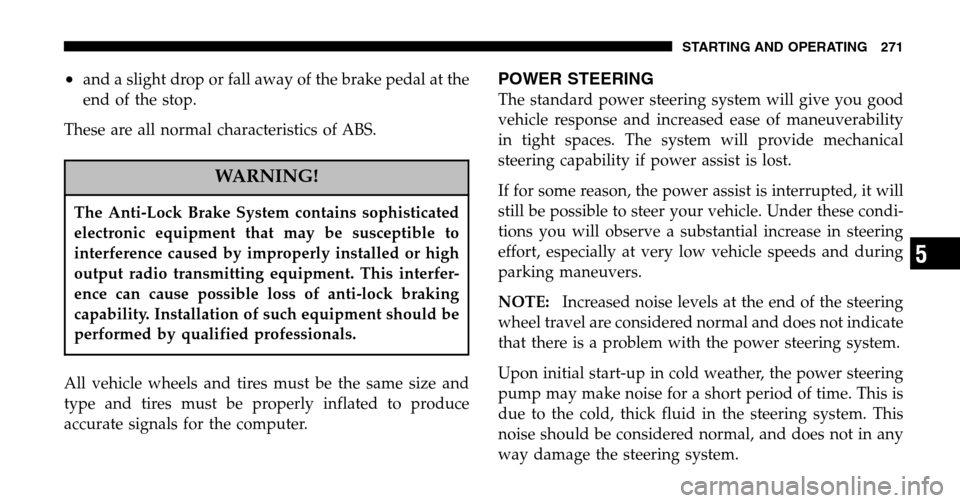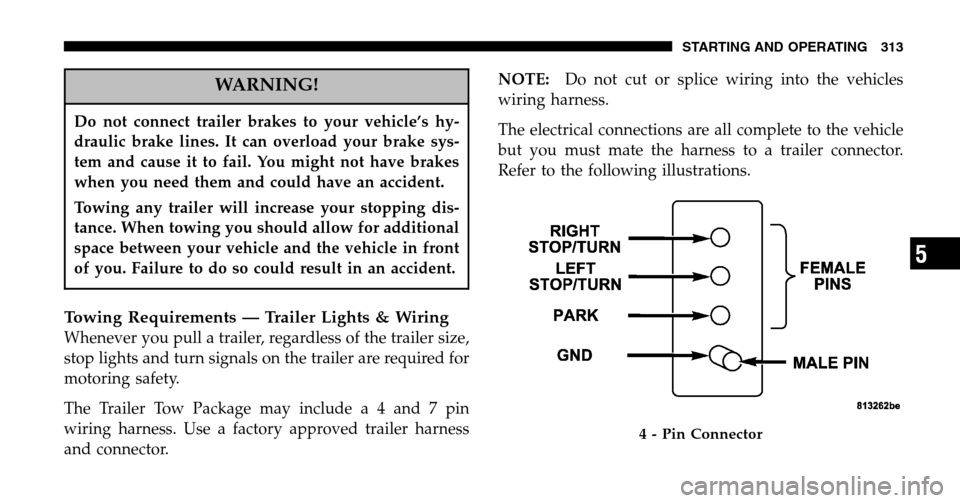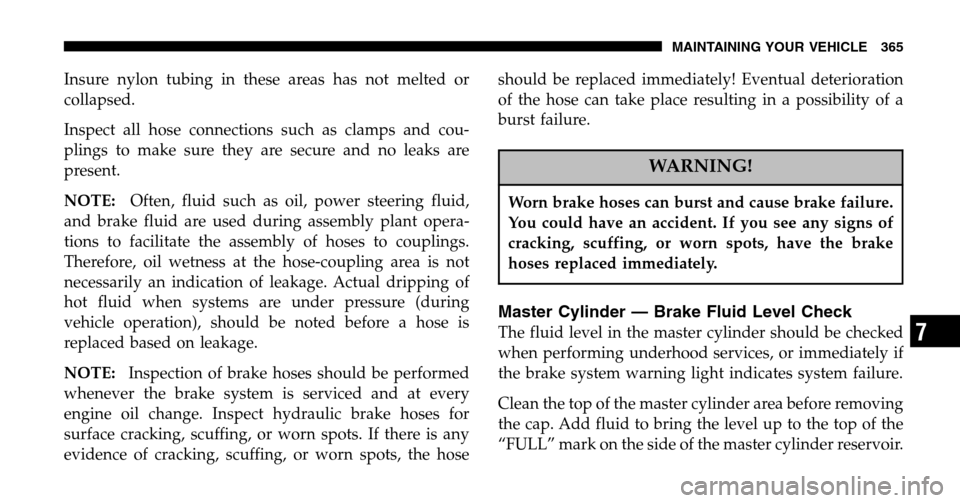Page 266 of 440

•If the system detects a problem it will disable the
AutoStick mode and the transmission will return to
the automatic mode until the problem is corrected.
ALL WHEEL DRIVE — IF EQUIPPED
This feature provides full time, on-demand, All Wheel
Drive (AWD). The system is automatic with no driver
inputs or additional driving skills required. Under nor-
mal driving conditions, the front wheels provide most of
the traction. If the front wheels begin to lose traction,
power is shifted automatically to the rear wheels. The
greater the front wheel traction loss, the greater the
power transfer to the rear wheels.
CAUTION!
All wheels must have the same size and type tires.
Unequal tire sizes must not be used. Unequal tire
size may cause failure of the power transfer unit
and/or the viscous coupling.
PARKING BRAKE
When the parking brake is applied with the ignition
switch on, the brake light in the instrument cluster will
turn on.
NOTE: This light only shows that the parking brake is
applied. It does not show the degree of brake application.
266 STARTING AND OPERATING
Page 270 of 440

The ABS light monitors the Anti-Lock Brake
System. The light will come on when the
ignition switch is turned to the ON position
and may stay on for as long as four seconds.
If the ABS light remains on or comes on while driving, it
indicates that the Anti-Lock portion of the brake system
is not functioning and that service is required. However,
the conventional brake system will continue to operate
normally if the BRAKE warning light is not on.
If the ABS light is on, the brake system should be serviced
as soon as possible to restore the benefits of Anti-Lock
brakes. If the ABS light does not come on when the
Ignition switch is turned to the ON position, have the
bulb repaired as soon as possible.
If both the Brake Warning Light and the ABS Light
remain on, the Anti-Lock brakes (ABS) and Electronic
Brake Force Distribution (EBD) systems are not function-
ing. Immediate repair to the ABS system is required. When the vehicle is driven over 7 mph (11 km/h), you
may also hear a slight clicking sound as well as some
related motor noises. These noises are the system per-
forming its self check cycle to ensure that the ABS system
is working properly. This self check occurs each time the
vehicle is started and accelerated past 7 mph (11 km/h).
ABS is activated during braking under certain road or
stopping conditions. ABS-inducing conditions can in-
clude ice, snow, gravel, bumps, railroad tracks, loose
debris, or panic stops.
You also may experience the following when the brake
system goes into Anti-lock:
•The ABS motor running (it may continue to run for a
short time after the stop),
•the clicking sound of solenoid valves,
•brake pedal pulsations,
270 STARTING AND OPERATING
Page 271 of 440

•and a slight drop or fall away of the brake pedal at the
end of the stop.
These are all normal characteristics of ABS.
WARNING!
The Anti-Lock Brake System contains sophisticated
electronic equipment that may be susceptible to
interference caused by improperly installed or high
output radio transmitting equipment. This interfer-
ence can cause possible loss of anti-lock braking
capability. Installation of such equipment should be
performed by qualified professionals.
All vehicle wheels and tires must be the same size and
type and tires must be properly inflated to produce
accurate signals for the computer.
POWER STEERING
The standard power steering system will give you good
vehicle response and increased ease of maneuverability
in tight spaces. The system will provide mechanical
steering capability if power assist is lost.
If for some reason, the power assist is interrupted, it will
still be possible to steer your vehicle. Under these condi-
tions you will observe a substantial increase in steering
effort, especially at very low vehicle speeds and during
parking maneuvers.
NOTE: Increased noise levels at the end of the steering
wheel travel are considered normal and does not indicate
that there is a problem with the power steering system.
Upon initial start-up in cold weather, the power steering
pump may make noise for a short period of time. This is
due to the cold, thick fluid in the steering system. This
noise should be considered normal, and does not in any
way damage the steering system.
STARTING AND OPERATING 271
5
Page 313 of 440

WARNING!
Do not connect trailer brakes to your vehicle’s hy-
draulic brake lines. It can overload your brake sys-
tem and cause it to fail. You might not have brakes
when you need them and could have an accident.
Towing any trailer will increase your stopping dis-
tance. When towing you should allow for additional
space between your vehicle and the vehicle in front
of you. Failure to do so could result in an accident.
Towing Requirements — Trailer Lights & Wiring
Whenever you pull a trailer, regardless of the trailer size,
stop lights and turn signals on the trailer are required for
motoring safety.
The Trailer Tow Package may includ ea4and7pin
wiring harness. Use a factory approved trailer harness
and connector. NOTE:
Do not cut or splice wiring into the vehicles
wiring harness.
The electrical connections are all complete to the vehicle
but you must mate the harness to a trailer connector.
Refer to the following illustrations.
4 - Pin Connector
STARTING AND OPERATING 313
5
Page 336 of 440

▫Front & Rear Suspension Ball Joints ........355
▫ Steering Shaft Seal ....................355
▫ Steering Linkage ......................355
▫ Drive Shaft Universal Joints ..............355
▫ Body Lubrication .....................356
▫ Windshield Wiper Blades ................356
▫ Windshield And Rear Window Washers .....357
▫ Exhaust System ......................357
▫ Cooling System .......................358
▫ Hoses And Vacuum/Vapor Harnesses .......363
▫ Brakes .............................364
▫ Master Cylinder — Brake Fluid Level Check . . 365
▫ Fuel System Hoses ....................367 ▫
Automatic Transmission ................367
▫ All Wheel Drive (AWD) — If Equipped .....370
▫ Front And Rear Wheel Bearings ...........372
▫ Appearance Care And Protection From
Corrosion ...........................372
▫ Cleaning The Center Console Cup Holders . . . 376
� Integrated Power Module (IPM) ............377
� Vehicle Storage ........................380
� Replacement Light Bulbs .................381
� Bulb Replacement ......................382
▫ Standard Quad Headlights ...............382
▫ High Intensity Discharge Headlights (HID) —
If Equipped .........................383
336 MAINTAINING YOUR VEHICLE
Page 365 of 440

Insure nylon tubing in these areas has not melted or
collapsed.
Inspect all hose connections such as clamps and cou-
plings to make sure they are secure and no leaks are
present.
NOTE: Often, fluid such as oil, power steering fluid,
and brake fluid are used during assembly plant opera-
tions to facilitate the assembly of hoses to couplings.
Therefore, oil wetness at the hose-coupling area is not
necessarily an indication of leakage. Actual dripping of
hot fluid when systems are under pressure (during
vehicle operation), should be noted before a hose is
replaced based on leakage.
NOTE: Inspection of brake hoses should be performed
whenever the brake system is serviced and at every
engine oil change. Inspect hydraulic brake hoses for
surface cracking, scuffing, or worn spots. If there is any
evidence of cracking, scuffing, or worn spots, the hose should be replaced immediately! Eventual deterioration
of the hose can take place resulting in a possibility of a
burst failure.
WARNING!
Worn brake hoses can burst and cause brake failure.
You could have an accident. If you see any signs of
cracking, scuffing, or worn spots, have the brake
hoses replaced immediately.
Master Cylinder — Brake Fluid Level Check
The fluid level in the master cylinder should be checked
when performing underhood services, or immediately if
the brake system warning light indicates system failure.
Clean the top of the master cylinder area before removing
the cap. Add fluid to bring the level up to the top of the
“FULL” mark on the side of the master cylinder reservoir.
MAINTAINING YOUR VEHICLE 365
7
Page 377 of 440
INTEGRATED POWER MODULE (IPM)
An Integrated Power Module is located in the engine
compartment near the battery. This center contains maxi
fuses, mini fuses and relays. A label that identifies each
component is printed on the inside of the cover.
Cavity Maxi Fuse Description
1 40 Amp Green Anti-Lock Brake System
(ABS) Pump
2 Spare
3 30 Amp Pink Ignition Off Draw (IOD)
4 40 Amp Green Body Control Module
(BCM) Feed 1
5 40 Amp Green Electronic Back Light (EBL)
6 30 Amp Pink Front Wipers
7 40 Amp Green Starter
8 40 Amp Green Power Seat C/B
9 40 Amp Green Power Sunroof
Integrated Power Module (IPM)
MAINTAINING YOUR VEHICLE 377
7
Page 378 of 440
Cavity Maxi Fuse Description
10 Spare
11 40 Amp Green Headlight Washer, Power
Liftgate
12 Spare
13 40 Amp Green Radiator Fan 1
14 Spare
15 40 Amp Green Anti-Lock Brake System
(ABS) Module
40 40 Amp Green Driver Door Node
41 40 Amp Green Passenger Door Node
42 40 Amp Green Front BlowerCavity Mini Fuse Description
24 20 Amp Yel- low Power Outlet (Selectable)
25 15 Amp Blue Radio, Amplifier, Naviga- tion, Hands-Free Phone
(HFM), Electronic Vehicle
Information Center (EVIC),
EC, SNRF, Mirror
26 20 Amp Yel- low Power Outlet
27 Spare
28 25 Amp Natural Horn
29 20 Amp Yel- low Cluster, CHMSL, Stop
Lights, Anti-Lock Brake
System (ABS)
30 10 Amp Red Ignition Switch
31 20 Amp Yel- low Hazard
378 MAINTAINING YOUR VEHICLE